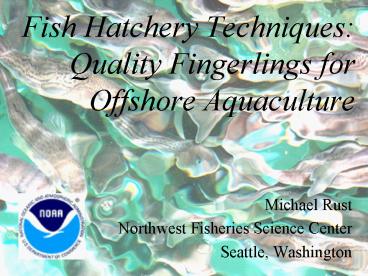Fish Hatchery Techniques: Quality Fingerlings for Offshore Aquaculture - PowerPoint PPT Presentation
1 / 18
Title: Fish Hatchery Techniques: Quality Fingerlings for Offshore Aquaculture
1
Fish Hatchery Techniques Quality Fingerlings
for Offshore Aquaculture
- Michael Rust
- Northwest Fisheries Science Center
- Seattle, Washington
2
Outline
- What is quality from the Hatchery?
- Healthy fish
- Weaned to Pelleted Feeds
- No defects
- Uniform Size
- Physiologically appropriate
3
Healthy Fish
- Goal Fish should be free of known diseases
- Approach - SPF hatcheries
- Goal Fish should be protected from potential
diseases - Approach
- Vaccination
- Nutrition
4
Automatic Vaccination Lines
5
(No Transcript)
6
Fish Weaned to Pelleted Diets
- Goal Fast Growth
- Goal Uniform Size
- Goal Cost Effective Feeding
- Goal Reduce Environmental Impacts
- Goal Healthy Fish
- Approach - Wean fish early and completely in
Hatchery - Approach - Complete Compound Feeds
- Approach - No Wet Fish (Trash Fish) Diets
7
No Defects
- Goal High Product Quality
- Approach - In Hatchery Provide Optimal
Environmental Conditions - Approach - Provide high quality diets
8
(No Transcript)
9
Developmental Anomalies (Temperature)
100
75
Other
Jaw
Total hatch
50
Spine
Normal
25
0
6
9
12
Temp (oC)
10
Developmental Anomalies (Salinity)
100
90
80
70
Other
60
Jaw
Total hatch
50
Spine
40
Normal
30
20
10
0
15
20
25
30
35
Salinity (ppt)
11
Uniform in Size
- Goal Uniform Product at Harvest
- Approach - Start with uniform graded fish
- Approach - Genetic Selection for Uniform High
Growth. - Approach - Completely weaned to High Quality
Pelleted diets.
12
Physiologically Appropriate
- Goal - Excellent Growth and Survival under
conditions in Offshore cages. - Perhaps lower Oxygen
- Perhaps stronger currents
- Approach - Species Selection
- Bioenergetics model under conditions likely to be
found at site.
13
Simple Bioenergetics Model
- E G R L
- Where
- E is the total energy taken in by the fish from
the diet - G is the amount of energy going into growth
- R is the amount of energy used for everything
that is not growh (movement, fighting diseases,
reproduction, etc) - L is the losses due from Feces, Urine and energy
to digest the feed (SDA)
14
Energy use curves for wild Blue Rockfish showing
energy partitioning.
Female
R
FUSDA
G
DB
6
?
Total
5
4
3
- Growth (G) represents a very small part of the
energy budget of wild animals. - Respiration (R) and Waste (FUSDA) represents
a large portion of the energy budget - Growth in farmed salmon can reach 50 of the
total energy budget
2
1
Yearly energy demand (MJ)
0
0
5
10
15
20
25
30
?
Male
6
5
4
3
2
1
0
0
5
10
15
20
25
30
Age (years)
15
Need to develop a simple bioenergetics model for
species of interest in off shore aquaculture
- Conditions off shore are likely to be different
than near shore. In Washington State it is
likely that they will have - Lower Oxygen
- Higher Currents
- than traditional near shore aquaculture areas
used by the salmon farming industry. - Potentially more energy will be needed for R
making less available for G. - The cost/benefit to G from increased/reduced R is
likely to be different among species - The cost/benefit to G from increased/reduced R is
likely to be different among sites.
16
Bioenergetics models can be developed for
different conditions and species using
respirametry
Flow DO out CO2 out
Flow DO in CO2 in
By measuring the uptake of Oxygen under various
conditions you can determine R and predict G
17
Summary
- What is quality? Its
- Healthy fish
- Weaned to Pelleted Feeds
- No defects
- Uniform Size
- Physiologically appropriate
18
Thank you































